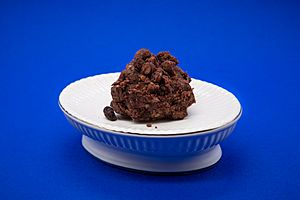Omegi-tteok facts for kids

A typical Omegi Tteok served on a plate
|
|
| Type | Tteok |
|---|---|
| Place of origin | Korea |
| Region or state | Jeju Province |
| Main ingredients | Millet, red bean |
| Korean name | |
| Hangul | |
|---|---|
| Revised Romanization | Omegi tteok |
| McCune–Reischauer | Omegi ttŏk |
Omegi Tteok is a special kind of tteok, which are Korean rice cakes. It comes from Jeju Island, the biggest island in Korea. Originally, Omegi Tteok was a small part of making a traditional drink called omegi sul.
But today, the Omegi Tteok you see in stores is quite different! It's made with new ingredients and is sold as a popular snack for tourists visiting Jeju Island. It's now one of the most popular souvenirs there!
Contents
Discover Omegi Tteok
How Omegi Tteok Began
The original Omegi Tteok and omegi sul were made from a special type of millet called chajo. This millet grew a lot on Jeju Island. Long ago, people on Jeju Island used chajo instead of rice or wheat. This is why Jeju's traditional food is different from other Korean foods.
Jeju Island had fewer types of food ingredients. So, its traditional dishes, like old Omegi Tteok, were often simple. People on Jeju Island didn't usually make tteok for snacks. They mostly used tteok as offerings during special events like gut, which are shamanistic rituals. Because of this, many old Jeju tteok didn't have strong flavors.
Making Traditional Omegi Tteok
To make traditional Omegi Tteok and omegi sul, you only needed chajo millet, yeast, and water. Even though most Omegi Tteok sold today is different, it's cool to learn about the old way!
First, the chajo millet was soaked in water. Then, it was ground into a powder. This powder was mixed with water and kneaded into a dough. The dough was shaped into small ovals with a hole in the middle, like a tiny donut. This shape helped them cook all the way through.
Next, these dough pieces were boiled in water. When they floated to the top, they were cooked and taken out. At this point, some of the cooked dough was set aside. This was the original Omegi Tteok! Before kids ate it as a snack, grown-ups would roll it in red bean gomul. This is a ground grain topping that helped stop kids from burning their tongues.
The rest of the cooked dough was kneaded again until it became a paste. Then, it was mixed with yeast to ferment into omegi sul. The original Omegi Tteok was not meant to be kept for a long time. It would get hard and not good to eat after just one day. This is why modern Omegi Tteok has changed a lot.
Modern Omegi Tteok
Omegi Tteok became very popular with tourists in South Korea around the early 2010s. Because of this, its look, taste, and ingredients have changed a lot. It's almost like a completely different kind of tteok now.
Today, chajo millet is not grown in large amounts anymore. So, most Omegi Tteok you buy in stores doesn't have chajo at all. The new Omegi Tteok uses the name and traditional look, but it's a new version.
To make it taste better for younger people, modern Omegi Tteok uses glutinous rice powder, mugwort, and sugar. The rice powder makes the tteok more chewy. Mugwort helps give it a green color, like the original. Sugar makes it sweeter, turning it into a popular dessert. These new ingredients also make it easier to store and ship Omegi Tteok across the country. Some sellers are even trying new toppings like nuts, or adding flavors like banana to the dough!

